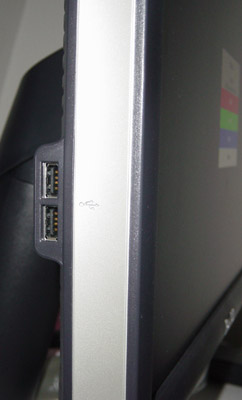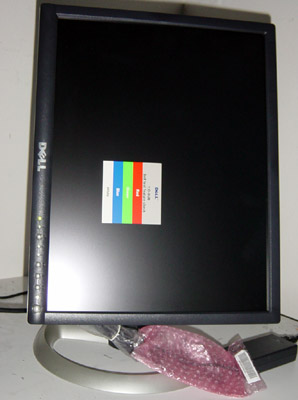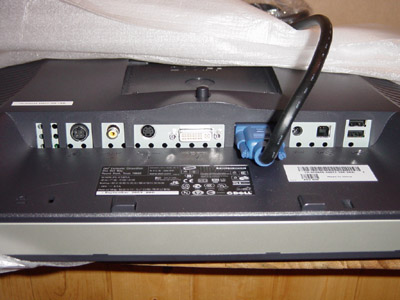Dell UltraSharp 2001FP Preview: Gaming LCDs for the Masses
by Kristopher Kubicki on November 10, 2003 12:36 AM EST- Posted in
- Displays
Construction
Dell's 1st and 2nd generation monitors can only be described as “clunky.” The 2000FP and 1702FP are notable monitors of good performance, but less than desirable style. It is obvious that Dell took a page from Samsung's 191T (or Dell 1901FP), when designing the 2001FP LCD. The bezel on the 2001FP is literally 1/3 that of the 2000FP. Also gone is the one piece design, in favor of a VESA compatible stand and screen.Click to enlarge.
We will touch more on the stand and base later, but it is fairly interesting how heavy the stand actually is. Since this monitor will tilt and swivel, the counterweights in the base effectively double the weight of the assembled unit.

Oddly enough, it looks like USB hubs on the monitor are back in vogue again, and you can see from a shot of the monitor inputs that the LCD accepts 2 USB outputs in the rear, and an additional two USB receptors on the left side of the monitor. This looks like a bit of an afterthought, but if you are used to having the USB ports on your monitor, it is a welcomed addition.
Click to enlarge.
From the picture above, you can see the 2001FP is not shy on inputs. From left to right, you can see inputs for power, composite video, S-Video, DVI, D-sub 15, Audio (for the AS500 sound bar, which was not included), USB 2.0 input, and 2 more USB outputs. The Genesis gm1601 chipset on the monitor is more than capable for these signals.
The screen itself is a very nice LG.Philips LCD LM201U04. This is perhaps the first true 16ms 24-bit LCD panel commercially produced and doesn't rely on over-inflated contrast ratio and brightness numbers to draw attention to itself. We will go into more detail about the panel later on.













53 Comments
View All Comments
jjll - Monday, December 15, 2003 - link
to those of you who have the 2001fp, are you happy with the lcd?Singletary - Monday, December 15, 2003 - link
You said: ". . . we ran ColorVision's Spyder and OptiCal software. Not only does this calibrate accurately the monitor on the DVI and analog interface . . . ."Because I can't afford this software, but have this monitor, would your friends allow you to share the calibration file for this monitor?
Thanks!
abster - Thursday, December 11, 2003 - link
I just got one. Did you try connecting it to a HDTV cable box? I am interesting in using it as a HDTV and PC monitor at the same time!randolo - Wednesday, December 10, 2003 - link
I just bought and set up two of the 2001FP's. Interestingly, one of them displays at 1600x1200 via analog just fine (no streakiness or blur), while the other is really streaky at 1600x1200, and less streaky (but still annoyingly unfocused) at 1280x1024. Gonna do some reorientation and box-swapping to try and isolate the source of the discrepancy between the two...MONSTERUS - Sunday, December 7, 2003 - link
Hi there! No offence,but there were several parts of review that I didn't like.Most important part:"By popular request".
*The Matrix Reloaded and The Matrix — As with our previous benchmarks, these are not spectacular movies to test colors subjectively*-
Than how come you tested them and not something more colorfull? Matrix movies are all in dark tones, so they will probably look good on almost any LCD monitor.
*both movies were quite acceptable on the 2001FP*-when they say something like that I begin to suspect that movies on this monitor are just "quite acceptible",hope you know what I mean,lets say 3 out of 5 - that's what is "acceptible"means for me :-)
Other concern is that while testing games seems like you only used on game rich in color depth -
Halo,and that was gosting.
Saying "For probably 2/3 of the games we play, pixel blur is not noticeable" makes me wander what kind of games you played more.
Didn't really understand about bluring in Halo,as you said camera captured some blur,but how about your feeling? Did it disturb the gameplay?How often blurin accured?All the time,or just in some scenes?
Lots of people still wander how UT2003 goes on this monitor,because lots of developers are going to use this 3D engine for their future games.
Another concern-there was no clear saying how good watching of DVDs is on this monitor from different angles. Was there big lack on colors and tones from viewing from angle?
Hope to see some answears soon,thank you!
golemite - Saturday, November 29, 2003 - link
"Halo — We had some mixed feelings while playing Halo. Granted, we spend a lot of time playing Halo on DLP screens via component input (PS2 of course)."dude, its called an XBOX ;P
maxter - Tuesday, November 25, 2003 - link
It's not fair to compare a 1280x1024 monitor to a 1600x1200 one. That aside, my old Radeon 8500 drives the samsung 213T at native DVI output flawlessly. I'd never go back to my CRT. The geometry is perfect, the color is stable and matches my print output perfectly, the gray scale levels are stable and accurate, the resolution is razor sharp edge to edge, and its easy on the eyes. It helps me spot flaws in my images that I never noticed on my CRT. Only drawback is that you can't view it from the sides, you have to have your eyes centered to the screen.henmaster - Friday, November 21, 2003 - link
Actually an 1600x1200 native LCD can also run 800x600 without interpolation, since it is a whole number multiple. So you dont need that great of a computer to run games full screen, without interpolation, on a 1600x1200 native LCD, as you can always bump the resolution down to 800x600.tygrus - Thursday, November 20, 2003 - link
The bulge near the end of the video cable is not an insulator and not a magnet. It is a Ferrite core (two halves) - it forms an inductor circuit with the cable running through it to filter spikes and filter some interference.Analog RGB signals are designed for CRT monitors. Remember that CRT's use electron guns emitting beams of electrons and electro-magnets to scan across a horizontal line hitting phosphorous dots. The signal then goes low (low electron gun emissions) while moving to the start of the next line (typically on the left). This means that any interference or poor signal quality (eg. slow slew rate) affects horizontal pixels. A slow slew rate will cause a smearing of the image horizontally. Poor signal termination (eg. Mismatch of impedance, earthing) can cause ghosting. Poor colour accuracy and interference can also be caused by cross-talk when signal wires are not properly shielded.
I've just done this quickly so let me know if you want more information.
~~~~~
PS. I'm not saying that this article is bad, the following is a comment/warning about articles/reviews in general in print/internet. I get frustrated with reviews that leave information out, make assumptions based on incomplete information or don't investigate/research.
lindloff - Tuesday, November 18, 2003 - link
The article does a good job of convering the new LCD. It does a bad job explaining the CONS of a LCD with a native resolution of 1600x1200.As with any LCD if you dont run your application at its "Native Resolution" it looks bad....just plain bad. Most people buying them dont understand this..and then think LCD's dont look good.
To run a new game like Halo on this LCD at its native resolution of 1600x1200, you would need a monster computer....like a P4 3.4EE to get any kind of playable FPS.
Sure it has that zoom out feature to avoid the problems of not using the native resolution...but then why have a 20inch LCD? It would be nice if they made a 20 inch LCD with great response times that came in different native resolutions.
I bought my 19inch because I did not have a system that could run a new game at 1600x1200 at good speed. 1280x1024 was my target, even then some games with my P4 2.4C and 9700Pro need to have AA turned off to get good FPS.